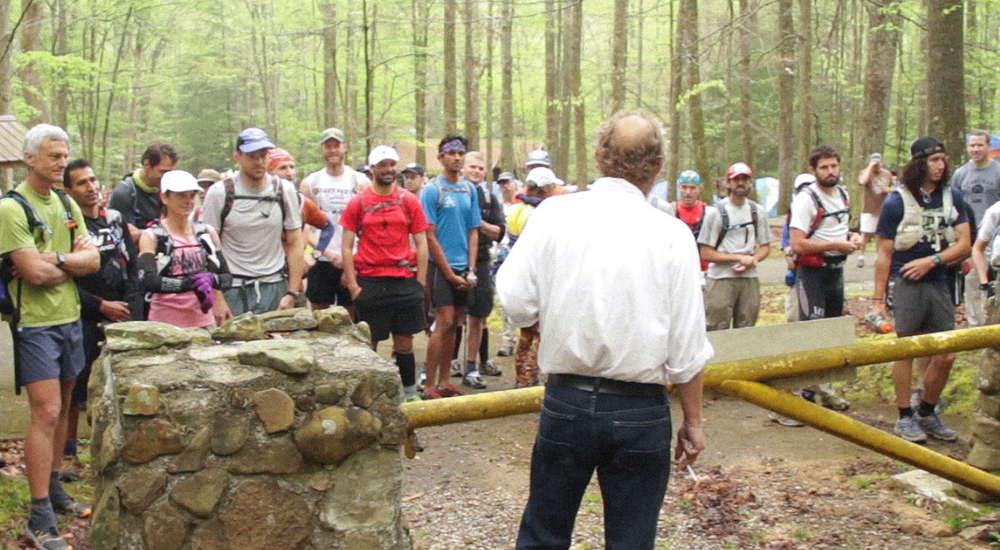If you didn’t know better, you’d think that Annika Iltis and Timothy Kane made an unforgivable typo in titling their feature debut “The Barkley Marathons,” having covered just one year of the event. However, no such mistake was made in naming the film, which covers the grueling endurance test that annually happens in Tennessee, cooked up by Lazarus Lake and Gary Cantrell as if it were a stew made by chefs using up all the leftovers from their daily specials from the previous week. Modeled after the route that Martin Luther King Jr. assassin James Earl Ray took when attempting to break out of prison in 1977, the race stretches out over Tennessee’s Frozen Head State Park, consisting of five loops that run over 100 miles combined with just 60 hours for runners to complete. However, it’s a physical and mental challenge that doesn’t just ask runners to find their way through the wilderness, but seek out books lining the trail and tear out a page corresponding with their registration number from each tome to demonstrate they’ve hit each checkpoint and few even complete the less daunting 60-mile “fun run” version, let alone the full race.
Still, thousands have applied for the few spots Lake has opened up to participate in the Barkley for the past 25 years, charging $1.60 entrance fee, a license plate from their home state or country and whatever piece of clothing he’s run out of during the past year. It was this strange fact, among others, that hooked Iltis and Kane, then camera assistants on the fifth season of “Mad Men,” on the idea of possibly making a film about the race. As tempting as it must’ve been for the filmmakers to simply follow the men and women crazy enough to take on the Barkley, Iltis and Kane do one better in essentially placing the audience there, unobtrusively peeking in at both the preparation for the event and the running of it, both sections equally full of twists and turns. However, in order to capture the race, Iltis, Kane and small but resilient crew had to essentially withstand the same obstacles as the participants did, only with heavy camera equipment to carry. After a celebrated festival run that began with a Jury Prize-winning debut at the Austin Film Festival last fall, “The Barkley Marathons” will be available everywhere this week on VOD and on the eve of its release, Iltis spoke about seeking out the secretive co-founder Lake and getting his permission to film and the grueling process of simply putting a feature documentary together, even before factoring in The Barkley.

We read Leslie Jamison’s essay in The Believer magazine, an amazing essay for anyone who’s interested in the Barkley Marathons or even if you’re not. We’re not necessarily sports-minded people at all, but what was so fascinating [beyond] just the bizarre event that takes place, was how she was able to capture Laz. By the end of it, you really feel like you were there. Once you start reading about the Barkley, you start trying to find out more because it is unbelievable. So all those elements were interesting to us, but it was just something so outside our world and even the realm of possibility, that it was interesting and once we started researching it, no one had really done anything documentary-wise about the Barkley.
You actually get a sense in the film that many of the participants aren’t necessarily participating for a workout, but an experience unlike anything other. Did you feel a kinship with them in that regard?
Yeah, I think it is similar in that way. The people that do the Barkley, a lot of them have graduate degrees, PhDs, and they’ve accomplished so much in their own lives, so they’re looking for a challenge — something that is almost impossible. For us, it was the same way, although I think had we looked at it that way, we probably would have been a little bit more wary of beginning the project. Working as camera assistants, there are challenging and less challenging days, but you know what you’re getting into every day. This was the biggest challenge either of us have ever had and we jumped right in. In the end, that was much more rewarding just because it was so difficult. Taking four years to get it out in the world shows that.
Was it difficult to even get in touch with Lazarus and the access to shoot this?
Finding Laz took a little bit of work, but once Tim did that and he was able to get in touch with him, he wasn’t saying no and he wasn’t really saying yes. Laz loves President State Park, a beautiful park in Tennessee where the [race] takes place at President State Park, and when we asked him initially, “Can we come and shoot a documentary about this race, he was like it’s a public park, I’m not going to stop you.”
When we did, we scouted a month ahead of time with him and once he got to know us, he was like “Okay, you guys are actually here, I guess you’re going to do this thing.” I think people have said before in the past that they were going to do something and some groups have actually gone and shot footage there, but nothing ever came of it. [Laz] knew that this was going to be a challenge for us, probably way more than we did, so maybe it was interesting for him to see what we would go through and come up with, but in the end, I think when he knew we weren’t going to expose the secrets of the race, he was on board. He loves the film.

We went on some hikes with [Laz], and he was able to show us certain places in the park where he would allow us to have a camera operator or an unmanned camera. The course is huge, at least 26 miles per loop. But we didn’t want to make this a running film by any means. That wasn’t really what interested us. We got some great footage, but we tried to remain as invisible as much as we could. We didn’t want to affect the race in that [the runners] would get the hint as to where they were if they were lost [if they say our cameras], so all the places [where we set up] didn’t affect any of the runners’ navigation, which ended up working out great for us because I don’t think we felt like we missed out on anything. The runners experienced the course almost exactly as they would if we weren’t there, which was important to us.
Unlike the runners, were you allowed to get any sleep?
We actually did. The very first day of the race, Tim went out to set a camera up [around] the very first book on the course and hike up Holly Hill, a pretty steep area down a ways He got lost for about 17 hours — he’ll say he wasn’t, but he got lost for a while — and he didn’t end up returning until 11:30 that night. He obviously needed sleep after that. We had about seven people with us that were operating on and off, so we were able to have ourselves and other people on shifts. Some stayed up into the night and then would go to sleep and we were able to get a bit of sleep. You see Laz [in the film], we would try to interview him a little bit towards the end where we were all sitting at the gate, waiting for someone to arrive and he becomes less and less understandable because he hasn’t slept in 60 hours. So we definitely factored in some time for sleep because we wanted to still have our mental faculties.

Yeah, it was tough to do. We had help from our editor Marianna Blanco, who was able to get us to a four-and-a-half hour [cut with] a lot of footage that we liked, then down to two and some [change]. We started cutting it ourselves, but it was great to have a fresh set of eyes on the footage and there were certain things that we fought for and certain things she fought for. Once we had that two hour-plus cut, we took it back after we had gone to the race again and edited it, [asking], “What isn’t moving the story forward?”
From the beginning, our whole idea with the film was that the Barkley race itself, and its history, was the main character. Obviously, Laz is a big part of that. That’s what we had in mind when we structured it [instead of] a lot of these running films, [where it’s] here are your main characters, here’s their background, here they’re at work and then you watch them go to the race. We didn’t want that. In the end, you do get to follow the stories of certain people, so you see the different types of people that come to the Barkley.
But also there’s this very important idea of success and failure. People who go into the Barkley pretty much know that they’re going to fail, so you’re not looking at it as an outsider going, “that guy won or lost.” With that in mind, we wanted to keep those varying degrees of successes and failure for the [participants] to their own definition of that. We wanted something with more layers and really show the physical, mental, psychological [exercise] that Laz brings into it, and show how really this is human spirit type of story. They don’t call people at the Barkley winners or losers. They call them “finishers” because they’re not really placed.

We’ve been in business now for a while — Tim even longer than I have. We’ve worked on a lot of different types of stuff, but never from start to finish on a documentary before, even as camera assistants. It’s a different world than working on big budget Hollywood movies or TV shows. But we wanted a challenge outside of the world that we normally work in — something a bit more human and down to earth — and it’s been the two of us from start to finish, so we’ve had to learn Premiere editing, Photoshop — all these different programs — and the business side of it: post-production and distribution. We’ve had help with editing and Tyler Givens is an amazing musician who did the score, and we never would have been able to do that.
But I don’t think we had an idea of what we were going to experience. That was probably for the best because if you said to yourself, “Am I going to want to work on this for four years and spend all of my free time [when I] tell my friends we can’t be there because we have to finish this thing by this deadline?” it would have been a difficult thing to start. But thankfully, we did because we learned so much from it. We’re glad that people are responding to it so positively. This experience over these last four years has really made the film for us.
“The Barkley Marathons” will be available on iTunes, Amazon, and Vudu on December 8th. It also continues to screen throughout the country. A full list of theaters and dates is here.




